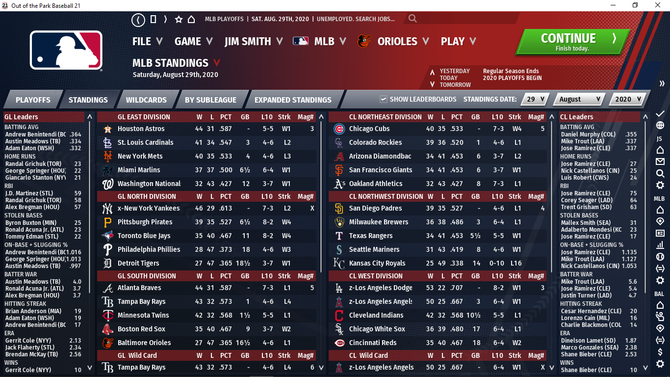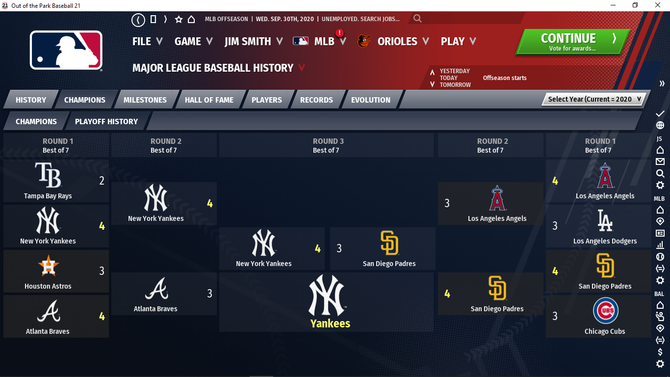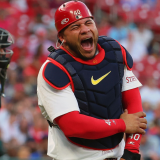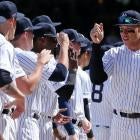With the coronavirus threatening Major League Baseball's 2020 season, the league and the players association have been brainstorming ways for the sport to return later this year. Predictably, some of those ideas have leaked to the public. One of the most intriguing scenarios, as reported by USA Today's Bob Nightengale, would have MLB forgoing the traditional American League/National League setup for the year.
Teams would instead be split into the "Grapefruit" and "Cactus" Leagues, and grouped geographically into six divisions.
Here's how the league would look for the 2020 season, per Nightengale:
GRAPEFRUIT LEAGUE
NORTH: New York Yankees, Philadelphia Phillies, Toronto Blue Jays, Detroit Tigers, Pittsburgh Pirates.
SOUTH: Boston Red Sox, Minnesota Twins, Atlanta Braves, Tampa Bay Rays, Baltimore Orioles.
EAST: Washington Nationals, Houston Astros, New York Mets, St. Louis Cardinals, Miami Marlins.CACTUS LEAGUE
NORTHEAST: Chicago Cubs, San Francisco Giants, Arizona Diamondbacks, Colorado Rockies, Oakland Athletics.
WEST: Los Angeles Dodgers, Chicago White Sox, Cincinnati Reds, Cleveland Indians, Los Angeles Angels.
NORTHWEST: Milwaukee Brewers, San Diego Padres, Seattle Mariners, Texas Rangers, Kansas City Royals.
That's not what we're accustomed to from MLB, and that's part of what makes it interesting.
Yesterday, we examined which teams would play in an easier/tougher division based on the proposed changes. Today, we're going to touch on what happens when you try to simulate the above scenario in the baseball simulation video game, Outside the Park Baseball 21.
Before we get to our takeaways from the season that was (or could be), we should note that we made other alterations as part of our game. Among them:
- Each team played about 75 regular season games
- We expanded rosters (to 30 players)
- We installed the DH universally
- We shortened the draft to five rounds (and were warned by the game that it would eventually lead to a shortage of players)
We also outlawed interleague play, since that would create more logistical issues. That meant, unfortunately, that teams ended up playing an uneven amount of games. Oh well. In the postseason, we ditched the Wild Card Game to make the playoffs simpler. We also expanded the division series to a best-of-seven with only four teams in each league making it October (or November, or December).
Now, let's get to our standings and five major takeaways.

1. The Padres might benefit more than any other team
We highlighted the Padres, and the rest of teams in the Cactus League Northwest Division, as clubs that could benefit most from this arrangement. There is no clear favorite among the five; no team that even projects to have a winning record, according to Baseball Prospectus' PECOTA.
In this simulation, the Padres emerged as the top dog with a 39-35 record. Their plus-53 run differential was the best in the Northwest, although everyone else (Milwaukee Brewers, Seattle Mariners, Texas Rangers, and Kansas City Royals) finished in the red.
There was just one other division where four of the five teams finished with negative run differentials, and that was the Grapefruit League's North Division, which featured the New York Yankees, Pittsburgh Pirates, Detroit Tigers, Toronto Blue Jays and Philadelphia Phillies.

Oddly enough, the Yankees and Padres met in the World Series. San Diego took a 3-2 lead in the best-of-seven series, but the Yankees were able to win Games 6 and 7 to claim the title.
2. The Cactus League West will be fierce
Remember how we expressed empathy toward the Cincinnati Reds, Chicago White Sox, Los Angeles Angels and even Cleveland for landing in the same division as the Los Angeles Dodgers? Well, our feelings were justified in this simulation.
The Dodgers won the Cactus League West division with a majors-best 70.7 winning percentage, because of course they did. They also had the best run differential in baseball (129). The rest of the division performed admirably, however. The Angels won 67 percent of their games, Cleveland won 57 percent of its games, and so on. The Reds finished last with a 46.7 winning percentage, which would have netted them third place in most of the other divisions. Brutal.
3. The Grapefruit League South could be, too
The Grapefruit League South wasn't quite as loaded as the Cactus League West, but the top three teams in the division -- the Atlanta Braves, Tampa Bay Rays and Minnesota Twins -- finished close to each other. How close? Just 1 1/2 games separated the trio at season's end.
The division came down to the final 10 games, and the Braves pulled ahead by virtue of going 7-3 in those contests. The Rays lost six of their last 10, and the Twins were 5-5 over that same span. Had there been a Wild Card Game, all three would have been in the postseason. They deserved as much, if you ask us.
4. The Royals really, really want Jack Leiter
As you can see above, the Royals finished with the worst record in the majors. That means they'll have the top pick in the 2021 draft, which is currently expected to be Vanderbilt right-hander Jack Leiter. (Things can change, so don't take that part for gospel.)
What's remarkable about the Royals winning the race to the bottom is how they did it. Kansas City dropped its final 16 games of the year, or nearly the final quarter of its schedule. To put that into perspective, it would be the equivalent of losing 35 consecutive games to close out a 162-game season.
By the way, the Royals fired manager Mike Matheny after the season. It's hard to argue that move was unwarranted.
5. Mike Trout: still good
No matter the season length, no matter the divisional alignment, no matter the roster size, one thing remains true: Mike Trout is very good at baseball.
In case you needed more evidence of that statement, consider that in this simulation, Trout hit .337/.484/.643 with 20 home runs and nine stolen bases in 75 games. His 5.6 Wins Above Replacement led the majors, and his 202 OPS+ was the best of his career.
As corny as it sounds, Trout's reliability would probably be more welcomed now than ever before.






















